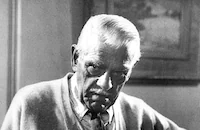The Ape
Brief Synopsis
Cast & Crew
William Nigh
Boris Karloff
Maris Wrixon
Gertrude W. Hoffman
Henry Hall
Gene O'donnell
Film Details
Technical Specs

Synopsis
Bernard Adrian, a sinister doctor obsessed with a determination to find a cure for the paralysis that killed his daughter, strikes fear in the people of the town in which he lives. His recent experiments are directed at Frances Clifford, a young crippled woman who reminds him of his late daughter. The doctor's opportunity to try his experimental serum presents itself when a traveling circus comes to town and an ape mauls its sadistic trainer. The critically injured man is brought to Dr. Adrian, who siphons the dying man's spinal fluids and injects then into Frances' bloodstream. Requiring more fluid to effect Frances' cure, the doctor finds the solution to his problem in the rampaging ape that has escaped from the circus and is terrorizing the town. When the ape breaks into the doctor's house, he slays the beast and dons its skin. Masquerading as the creature, Adrian then murders Mason, a cruel and abusive man, and injects his spinal fluid into Frances. Adrian's treatments prove successful as the feeling gradually returns to Frances' legs, but the sheriff and coroner become suspicious of the doctor and stake out his house. While stalking the countryside in search of victims to fuel his experiment, Adrian is mistaken for the creature and shot by one of the sheriff's men. As the doctor lies dying from the bullet wound, Frances pulls herself up from her wheelchair and steps toward the man who has restored her power to walk.

Director
William Nigh
Cast

Boris Karloff

Maris Wrixon
Gertrude W. Hoffman
Henry Hall
Gene O'donnell
Jack Kennedy
Jessie Arnold
Dorothy Vaughan
Philo Mccullough
Selmer Jackson
George Cleveland
Crew
C. J. Bigelow
Richard Carroll
Scott R. Dunlap
E. R. Hickson
Edward Kay
William Lackey
Harry Neumann
Russell Schoengarth
Kurt Siodmak
Kurt Siodmak
Allen Wood
Karl Zint

Film Details
Technical Specs

Articles
The Ape
The bizarre plot (some critics found it distasteful), involving that Monogram/PRC staple - the escaped gorilla and the mad scientist - is given an extra twist by having the fanatical physician spurred by good intentions: a cure for polio. That his research involves assuming the guise of a missing circus simian and murdering innocents for their spinal fluid is probably not procedure condoned by the AMA. Much of the weird science stuff is due to co-scripter Curt Siodmak (1902-2000), writer of such horror classics as The Wolf Man (1941), Donovan's Brain (1953) and Son of Dracula (1943); directed by his brother, film noir specialist Robert Siodmak.
The evolution of The Ape from script to screen was guided by Monogram's prolific house director William Nigh (1881-1955) whose career began in the silent days. He honed his craft on both sides of the camera as an actor, writer, editor and producer (often wearing all hats at the same time) before launching his directorial debut with Salomy Jane (1914). His fast-paced assembly-line method of getting the job done endeared him to the lower echelons of filmdom, where he belted out virtually every kind of movie thrown his way - action, westerns, musicals, mysteries, comedies, dramas, horror, war stories and even film noir. Directing such cult favorites as Bela Lugosi and The East Side Kids has made Nigh's work more visible to modern audiences on TV and video than that of his many higher profile contemporaries like Frank Lloyd and Clarence Brown. Perhaps this ironic fame is fate's payback to the industry majors for virtually shunning him, especially since one of Nigh's earliest efforts, My Four Years in Germany (1918), is the picture that put the struggling Warner Brothers on the map.
And now for the really important question - who is that man in the gorilla suit? Well, the title role in The Ape is impersonated by the aptly dubbed Ray "Crash" Corrigan (1902-1976). Corrigan, an agile stunt man, often donned the primate skins, threatening to give The Flicker's Number One ape-man extraordinaire, Charlie Gemora, a run for his money. Corrigan, who could also play heroic leads (see the Republic 1936 serial, Undersea Kingdom), went "bananas" in such neo-classics as Tarzan and his Mate (1934), Captive Wild Woman (1943), Nabonga (1944), White Pongo (1945) and The Monster and the Ape (1945) before reaching immortality as the extraterrestrial bloodsucker in 1958's It! The Terror From Beyond Space - the chiller generally acknowledged as the inspiration for Alien (1979).
One of nine pictures Boris Karloff made in 1940, The Ape is probably not considered one of the crowning achievements in his long career. Yet, as usual, the wonderful actor gave his all to this modest effort, the conclusion to his Monogram contract which was dominated by his Charlie Chan-esque Mr. Wong detective series.
During the production of The Ape, Karloff was basking in both personal and professional joy - the former being the celebration of his daughter Sara Jane's second birthday, and the latter his profitable relationship with producers Howard Lindsay and Russell Crouse on their new Broadway play, Arsenic and Old Lace. The role of the sinister Jonathan Brewster, the deliciously evil member of an oddball homicidal family, was written expressly for the actor, and would prove to be one of Karloff's biggest successes on the stage.
Producer: Scott R. Dunlap, William T. Lackey
Director: William Nigh
Screenplay: Curt Siodmak, Adam Shirk (play), Richard Carroll
Art Direction: E.R. Hickson
Cinematography: Harry Neumann
Film Editing: Russell F. Schoengarth
Original Music: Edward J. Kay
Cast: Boris Karloff (Dr. Bernard Adrian), Maris Wrixon (Frances Clifford), Gertrude W. Hoffman (Mrs. Clifford), Henry Hall (Sheriff Jed Halliday), Gene O'Donnell (Danny Foster).
BW-65m.
by Mel Neuhaus

The Ape
Quotes
Trivia
The play opened in Los Angeles, California, USA on 13 December 1927.
Notes
Adam Hull Shirk's play also served as the basis for The House of Mystery .














